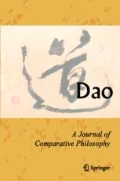Abstract
Jizang 吉藏 (549−623 CE), the key philosophical exponent of the Sanlun 三論 school of Chinese Buddhism, based his philosophy considerably on his reading of the works of Nāgārjuna (c. 150−250 CE), the founder of the Indian Madhyamaka school. However, there are salient features in his thought on language that are notably absent from the works. In this article, I present a philosophical analysis of Jizang’s views of the relationship between speech and silence and compare them with those of Nāgārjuna. It is shown that while Nāgārjuna leans toward affirming a clear-cut distinction between speech and ineffable quiescence, Jizang endorses the nonduality of conventional speech and sacred silence.
Similar content being viewed by others
References
Abe, Masao. 1985. Zen and Western Thought. Edited by William R. LaFleur. Honolulu: University of Hawaii Press.
Arnold, Dan. 2005. Buddhists, Brahmins, and Belief: Epistemology in South Asian Philosophy of Religion. New York: Columbia University Press.
Bailun Shu 百論疏 (A Commentary on the Śata Śāstra). By Jizang. In T, vol. 42, no. 1827.
Bhattacharya, Kamaleswar, E. H. Johnston, and Arnold Kunst, eds. & trans. 1990. The Dialectical Method of Nāgārjuna: Vigrahavyāvartanī. Delhi: Motilal Banarsidass.
Cheng, Hsueh-li. 1984. Empty Logic: Mādhyamika Buddhism from Chinese Sources. New York: Philosophical Library.
D’Amato, Mario. 2009. “Why the Buddha Never Uttered a Word.” In Pointing at the Moon: Buddhism, Logic, Analytic Philosophy. Edited by Mario D’Amato, Jay L. Garfield, and Tom J. F. Tillemans, 41−55. New York: Oxford University Press.
Dasheng Xuanlun 大乘玄論 (A Treatise on the Profound Teaching of the Mahayana). By Jizang. In T, vol. 45, no. 1853.
De La Vallée Poussin, L., ed. 1992. Mūlamadhyamakakārikās de Nāgārjuna avec la Prasannapadā commentaire de Candrakīrti. Delhi: Motilal Banarsidass.
Edgerton, Franklin. 1998. Buddhist Hybrid Sanskrit Grammar and Dictionary, vol. 2. Delhi: Motilal Banarsidass.
Erdi Yi 二諦義 (The Meaning of the Two Truths). By Jizang. In T, vol. 45, no. 1854.
Garfield, Jay L. 2002. Empty Words: Buddhist philosophy and cross-cultural interpretation. New York: Oxford University Press.
Ho, Chien-hsing. 2010. “Nāgārjuna’s Critique of Language.” Asian Philosophy 20.2: 159−174.
Jingming Xuanlun 淨名玄論 (A Treatise on the Profound Teaching of Vimalakīrti). By Jizang. In T, vol. 38, no. 1780.
Kajiyama, Yuichi. 1971. The Logic of Emptiness 空の論理, Part I. Edited by Yuichi Kajiyama and Ueyama Shunpei. Tokyo: Kadokawa Shoten 角川書店.
Lindtner, Chr. 1987. Nagarjuniana: Studies in the Writings and Philosophy of Nāgārjuna. Delhi: Motilal Banarsidass.
Liu, Ming-wood. 1994. Madhyamaka Thought in China. Leiden, New York, and Köln, E J Brill
Murti, T. R. V. 1955. The Central Philosophy of Buddhism. London: George Allen and Unwin.
Nagao, Gadjin. 1989. The Foundational Standpoint of Mādhyamika Philosophy. Translated by John P. Keenan. Albany: State University of New York Press.
_____. 1991. Mādhyamika and Yogācāra. Edited & translated by Leslie S. Kawamura. Albany: State University of New York Press.
Saigusa, Mitsuyoshi. 1985. Nāgārjuna’s Mūlamadhyamakakārikās: Texts and Translations. Tokyo: Daisanbunmei-sha.
Shengman Baoku 勝鬘寶窟 (The Jewel Cave of the Śrīmālā Sūtra). By Jizang. In T, vol. 37, no. 1744.
Siderits, Mark. 1989. “Thinking on Empty: Madhyamaka Anti-realism and Canons of Rationality.” In Rationality in Question: On Eastern and Western Views of Rationality. Edited by Shlomo Biderman and Ben-Ami Scharfstein. Leiden: E. J. Brill.
_____. 2003. “On the Soteriological Significance of Emptiness.” Contemporary Buddhism 4.1: 9−23.
Takakusu, Junjirō, and Watanabe Kaigyoku, eds. 1924−34. Taishō Shinshū Daizōkyō (abbreviated as T). 85 vols. Tokyo: Taishō Issaikyō Kankōkai.
Tanji, Teruyoshi. 2000. “On Samāropa: Probing the Relationship of the Buddha’s Silence and His Teaching.” In Wisdom, Compassion, and the Search for Understanding: The Buddhist Studies Legacy of Gadjin M. Nagao. Edited by Jonathan A. Silk. Honolulu: University of Hawaii Press.
Vimalakīrtinirdeśa Sūtra. 2006. In Vimalakīrtinirdeśa: A Sanskrit Edition Based upon the Manuscript Newly Found at the Potala Palace. Edited by Study Group on Buddhist Sanskrit Literature, the Institute for Comprehensive Studies of Buddhism, Taisho University. Tokyo: Taisho University Press.
Wang, Youru. 2003. Linguistic Strategies in Daoist Zhuangzi and Chan Buddhism: The Other Way of Speaking. London and New York: RoutledgeCurzon.
Weimojie Suoshuo Jing 維摩詰所說經 (The Vimalakīrtinirdeśa Sūtra). Trans. by Kumārajīva. In T, vol. 14, no. 475.
Westerhoff, Jan. 2009. Nāgārjuna’s Madhyamaka: A Philosophical Introduction. New York: Oxford University Press.
Williams, Paul. 1991. “On the Interpretation of Madhyamaka Thought.” Journal of Indian Philosophy 19.2: 191−218.
Yang, Huinan 楊惠南. 1989. Jizang 吉藏. Taipei: Donda Tushu 東大圖書.
Zhongguanlun Shu 中觀論疏 (A Commentary on the Middle Treatise). By Jizang. In T, vol. 42, no. 1824.
Zhonglun 中論 (The Middle Treatise). Trans. by Kumārajīva. In T, vol. 30, no. 1564.
Zhuangzi Yinde 莊子引得 (A Concordance to Chuang Tzu). 1956. Harvard-Yenching Institute Sinological Index Series, Supplement no. 20. Cambridge, MA: Harvard University Press.
Author information
Authors and Affiliations
Corresponding author
Rights and permissions
About this article
Cite this article
Ho, Ch. The Nonduality of Speech and Silence: A Comparative Analysis of Jizang’s Thought on Language and Beyond. Dao 11, 1–19 (2012). https://doi.org/10.1007/s11712-011-9263-9
Published:
Issue Date:
DOI: https://doi.org/10.1007/s11712-011-9263-9




